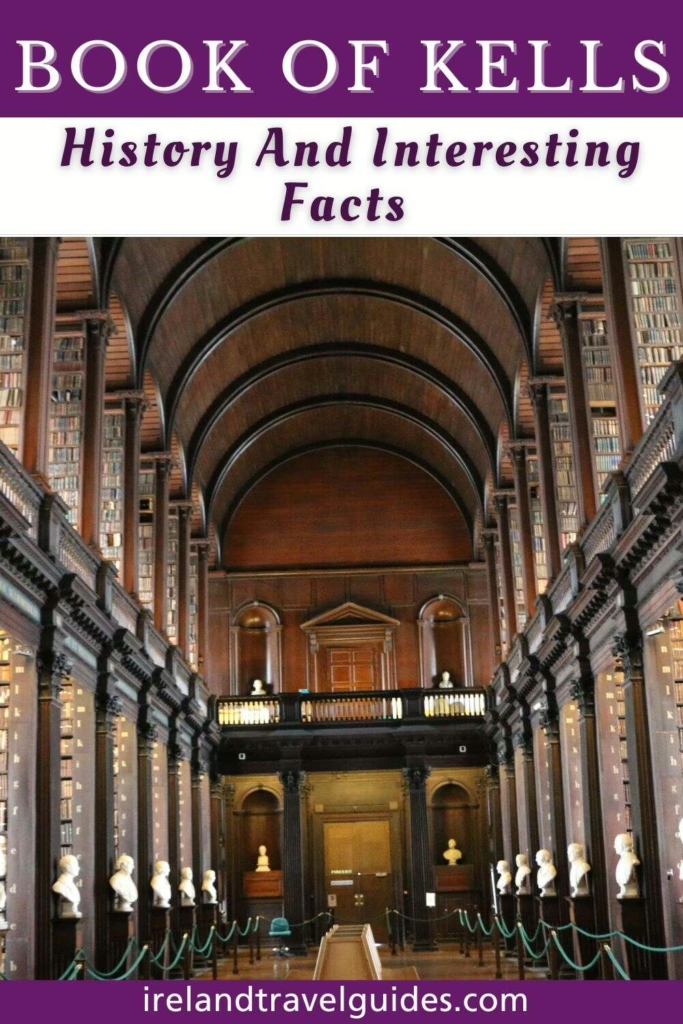The Book of Kells is an illuminated manuscript of the four gospels of the Christian New Testament that is now housed at Trinity College in Dublin, Ireland.
It was created around 800 CE. The work is the most famous of the medieval illuminated manuscripts because of the intricacy, detail, and majesty of the pictures.
Things you'll find in this article
- Book Of Kells – History And Interesting Facts
- Book Of Kells History
- Book Of Kells Interesting Facts
- 1. The Book Of Kells was once stolen.
- 2. The Book Of Kells has pages missing.
- 3. The drawings and embellishments are lavish and intricate.
- 4. The Hiberno-Saxon style is used to write the Book Of Kells.
- 5. The Book Of Kells is chock-full of fascinating details.
- 6. The Book Of Kells inspired an animated film.
- 7. In 2018, the Book Of Kells drew over one million visitors.
- 8. The Book Of Kells is a significant piece of Irish history and culture.
Book Of Kells – History And Interesting Facts

Book Of Kells History

The Book of Kells was created in 800 AD in Iona or Kells, both in Meath County, Ireland. Many historians believe it originated on Iona and was transported to Kells for safety.
In any case, the manuscript was developed by monks who learned their profession at Iona, a major center of religious education at the period. Vikings periodically invaded it as they crossed Ireland, robbing and settling in neighboring cities.
As a result, the monks had to flee for safer ground. They set up a camp at Kells and built a massive complex before returning to their tasks.
In 1654, Cromwell’s soldiers were quartered in the Church of Kells, and the town’s ruler sent the Book to Dublin.
Henry Jones, except for a few international exhibitions, ensured the Book’s safety until it was sent to Trinity College Dublin in 1661.
The text has evolved, with the chapters of the Gospels getting roman numerals and the pages being counted and numbered. Rebounding the text numerous times was required to keep it intact.
During one binding, pages were clipped and pictures were trimmed. They had to be kept separate since some pages broke loose in another binding.
Roger Powell’s most recent and longest-lasting binding was finished in 1953. He bound the book in four volumes and treated the pages to keep them from crumbling.
Book Of Kells Interesting Facts

1. The Book Of Kells was once stolen.
The manuscript was first mentioned in the Annals of Ulster. The “biggest relic of the Western World” was allegedly stolen from Kells in 1006 for its exquisite cumdach (shrine).
The book was found buried in the earth but without its ornamental cover. It was returned to Kells and stayed until the monastery was dismantled.
2. The Book Of Kells has pages missing.
Since 1953, the Book of Kells has been divided into four volumes, two of which are displayed at a time.
One of the ornate pages is normally exposed when one is opened, and the other has two script pages. Pictures and text gaps, however, show that around 30 folios have gone lost over time.
Most of these folios were probably lost during the Middle Ages. The lost folios from the document’s beginning and finish are presumably due to the force used to pull it from its cover when it was stolen from Kells.
3. The drawings and embellishments are lavish and intricate.
Traditional Christian imagery, as well as complex swirling elements seen in Insular art, are combined in the Book of Kells.
The manuscript’s pages are alive with figures of humans, animals, and legendary beings, as well as Celtic knots and interlacing patterns in brilliant hues.
Many of the minor decorative elements are filled with Christian symbolism, bringing the big images’ themes to life.
4. The Hiberno-Saxon style is used to write the Book Of Kells.
The Hiberno-Saxon style, which initially appeared in the seventh century, is a hybrid of Irish-Celtic curvilinear motifs and ornate initials with Anglo-Saxon zoomorphic interlacing and brilliant coloring. The style is defined by geometric design, huge amounts of color, and intricate interlaced patterns.
5. The Book Of Kells is chock-full of fascinating details.
The manuscript now consists of 340 leaves or folios, each of which contains 680 pages on the recto and verso.
Since 1953, it has been produced in four volumes, each measuring 330 mm by 250 mm. (Dimensions: 13 x 9.8 inches)
The leaves are made of high-quality calf vellum, and the unprecedentedly ornate ornamentation that covers them includes ten full-page illustrations and text pages that are vibrant with decorated initials and interlinear miniatures, representing the anti-classical and energetic qualities of Insular art to the fullest extent.
The lettering is done in iron gall ink, and the colors were made with a variety of materials, some of which were imported from other countries.
6. The Book Of Kells inspired an animated film.
The animated film The Secret of Kells, which was released in 2009, is based on the fictional story of an elderly monk Aidan and his young apprentice Brendan, who are attempting to complete the Book of Kells in the face of Viking assaults.
It was directed by Tomm Moore and was nominated for an Academy Award in 2009 for Best Animated Feature.
7. In 2018, the Book Of Kells drew over one million visitors.
The Book of Kells at Trinity College Dublin has seen an average of 500,000 visitors every year, with an upward trend.
The place had 662,679 visitors in 2014 and a million in 2018. According to sources, about a third of visitors to the Book of Kells in 2018 were Americans.
Prince Harry and Meghan Markle were among the many admirers of the Book of Kells who visited Dublin in July 2018.
8. The Book Of Kells is a significant piece of Irish history and culture.
Irish people throughout the world hold the Book of Kells in high regard. It’s an example of Insular illustration as well as a work of art in elaborate and beautiful calligraphy.
The Book of Kells also exemplifies the artistry and skills of medieval Irish monks and intellectuals. It is often regarded as Ireland’s greatest national treasure.
Following Saint Patrick’s conversion of the Irish to Christianity, this ancient book mixes Christian and Celtic iconography in an iconic work of art, reflecting the merging of these two cultures.

Hi, I’m Christine – a full-time traveler and career woman. Although I’m from the Philippines, my location independent career took me to over 60 countries for the past 12 years. I also lived in 4 continents – from the Caribbean, South East Asia, Africa and now in Europe. But despite living in several countries, my love for Ireland remains the same. A country that had been a part of my life since I was 14 because of my love for Irish music and bands. Ireland Travel Guides was born because of this passion and hopefully, in some little ways, this website will be able to help you on your next trip to Ireland.
11 Best Museums In Dublin, Ireland - Ireland Travel Guides
Wednesday 1st of December 2021
[…] starting with the origins of the Irish storytelling tradition, which features a facsimile of the Book of Kells and progresses from […]